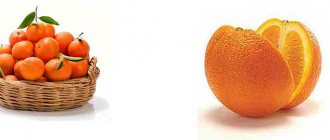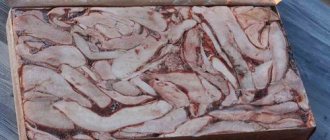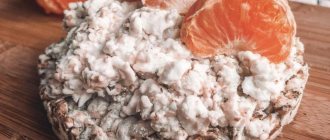Chickpeas (lamb or chickpeas) are a legume plant that is common in Australia, America, Africa and Asia. Currently, it can be bought in almost any store. Chickpeas are yellow, green or brown beans shaped like a lamb's head with a pointed nose. The nutritious product is used to prepare first and second courses, as well as the famous hummus. Eating chickpeas should be done with caution, as they cause increased gas formation.
- Hummus
Product Description
Chickpeas have long been used for culinary purposes due to their pleasant taste and many compounds in their composition. Before including a product in your diet, you need to know its benefits and harms to the health of the body.
What kind of peas are these?
Chickpea is a legume that has an erect stem covered with glandular hairs and odd-pinnate leaves. The fruit is a short, swollen bean containing from 1 to 2 seeds, sometimes their number increases to 4. The seed externally resembles the head of an owl or a ram, has a lumpy, rough surface of yellow or brown color.
Photo of the plant
In Egypt, Iran, India, Italy and other countries they know what this product is, what its benefits are, and they use it to prepare traditional oriental dishes. Chickpeas also have other names: lamb peas, nohut, chickpeas.
Compound
This representative of the flora has a balanced chemical composition containing many components:
- amino acids, including large amounts of methionine and tryptophan;
- isoflavones;
- starch, natural sugars;
- vitamins and microelements;
- alimentary fiber.
These substances will ensure good health, maintain tone, add vitality, and allow you to withstand a long, grueling diet.
The nutritional value
The composition is rich in protein, fatty acids and natural sugars.
Energy value in 100 g of mature chickpea seeds:
| Proteins (g) | Fat (g) | Carbohydrates (g) |
| 20,47 | 6,04 | 62,95 |
BJU of raw chickpeas
Nutritional value per 100 g of chickpeas, cooked without salt:
| Proteins (g) | Fat (g) | Carbohydrates (g) |
| 8,86 | 2,59 | 27,42 |
BJU of cooked chickpeas
Calorie content
100 g of mature seeds of the culture contain 378 kcal. 100 g of cooked product without salt - 164 kcal. Low calorie content and the presence of fiber explain the benefits and active use of chickpeas for weight loss, to normalize the functioning of the digestive system and eliminate the feeling of hunger.
Vitamins and microelements
The effect of chickpeas on the body is due to the presence of a complex of vitamins and minerals in its composition:
| Vitamins | Minerals | ||
| A | 1 mcg | Calcium | 49 mg |
| IN 1 | 0.12 mg | Magnesium | 18 mg |
| AT 2 | 0.06 mg | Phosphorus | 168 mg |
| AT 3 | 0.53 mg | Potassium | 291 mg |
| AT 5 | 0.29 mg | Sodium | 7 mg |
| AT 6 | 0.14 mg | Zinc | 1.53 mg |
| AT 9 | 172 mcg | Manganese | 21.306 mg |
| WITH | 1.3 mg | Copper | 0.656 mg |
| E | 0.35 mg | Iron | 6.24 mg |
| TO | 4µg | ||
Health Benefits
The benefits of chickpeas for the body are determined by its composition. When adding a product to the menu:
- will serve as a source of energy;
- improves digestion;
- cleanses the body and breaks down fats;
- will relieve the feeling of hunger.
The benefits and harms to men's health are manifested in their effect on the digestive process. Chickpeas help maintain muscle mass at the required level for athletes and people involved in hard work. Also, the benefits of chickpeas for men are expressed in the rapid restoration of strength after physical activity.
It is important to note that chickpeas contain compounds that are difficult for the body to digest. This can cause flatulence and intestinal discomfort.
The benefits for women are due to the increased fiber content. Peas cleanse the intestines, normalizing its functioning and preventing constipation. The harm manifests itself in the form of exacerbations of gastrointestinal diseases.

Boiled chickpeas
The benefit of chickpeas is that, for example, it helps women in the fight against excess weight without any harm to health.
Contraindications
In addition to its beneficial properties, chickpeas have contraindications for diseases:
- thrombophlebitis;
- cystitis - inflammation of the bladder;
- gout, as chickpeas increase the formation of uric acid;
- ulcerative formations of the stomach and intestines;
- exacerbation of gastritis.
Attention! An absolute contraindication for eating chickpeas is an allergy to cereal protein. Turkish peas cause increased gas formation. A person with digestive system problems should limit it in their diet. A nursing woman should avoid chickpeas if the baby is not yet 4 months old.
This product has very few contraindications; they boil down to bladder ulcers, individual intolerance and a tendency to increased gas formation. It should be used with caution in old age and very young children due to the risk of flatulence.
If you are still not familiar with this product, it’s time to evaluate its taste and benefits. Due to minimal contraindications, chickpeas are an excellent part of the diet of many people, enriching the body with essential substances and protecting against diseases. Show your imagination, experiment, and you will surely surprise your loved ones with a wonderful dish of chickpeas!
What can we say about roasted chickpeas with salt?
The benefits and harms of chickpeas fried with salt largely depend on following the cooking recommendations. During the cooking process, it is important to consider some points:
- Fry chickpeas only in good quality refined oil.
- After frying, place the beans on paper to remove excess fat.
- Sprinkle the finished dish with salt or sugar.
It is important to note that the benefits of fried chickpeas during heat treatment are significantly reduced due to the destruction of many compounds. Frequent and excessive use of it can provoke:
- excessive gas formation;
- allergic reactions;
- exacerbation of ulcers, gout.
Only after studying the benefits and harms of fried chickpeas can you add the product to the menu.
Use in cooking in different countries
The culinary uses of this legume are very diverse. Salads, appetizers, first and second courses are prepared on the basis of chickpeas.
- Chickpeas are a nutritious, slightly heavy product, so after eating them, at least 4 hours should pass before the next meal so that the legumes have time to digest properly.
- To avoid fermentation, chickpea dishes should not be washed down with water.
- It is advisable to consume one type of protein per meal (in our case, only chickpeas).
- Avoid simultaneous use with bread and potatoes.
- Like other legumes, chickpeas can cause flatulence. To weaken this effect, dishes made from it need to be supplemented with carminative products (fennel, dill, cilantro).
Of course, the most famous chickpea dishes are falafel and hummus.
Hummus is a snack with the consistency of a paste, to which, in addition to chickpeas, garlic, olive oil, paprika, lemon juice and ground sesame are added. Distributed throughout the Middle East.
Sprouted chickpeas
Sprouted chickpeas contain more nutrients than dry or cooked ones. The product is used as an independent dish. It also serves as an ingredient in the preparation of salads and smoothies.
In addition to its benefits, sprouted chickpeas can cause harm to the body. It is contraindicated for people with irritable bowel syndrome, ulcers and erosions of the stomach and duodenum.
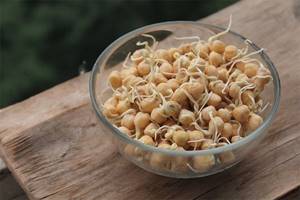
Chickpea sprouts
Hummus (Jewish cuisine)
This dish is chickpea porridge, supplemented with various spices. In Israel, tahini is added to hummus, but it is too expensive here. However, you can do without it. Chickpea beans (125 grams) should be soaked overnight. Then add the liquid and let it cook in clean water. Cook until the peas are completely softened – about an hour and a half.
https://www.youtube.com/watch?v=ytcopyrightru
Grind three tablespoons of white sesame seeds in a coffee grinder. Strain the boiled chickpeas. Add ground sesame seeds, two tablespoons of lemon juice and four tablespoons of olive oil. Squeeze two or three cloves of garlic through a press into the total mass. Beat with a mixer or immersion blender. Season with salt, black pepper and sweet paprika. Serve the hummus with freshly baked flatbreads.
At what age can it be given to children?
Many mothers are interested in at what age can children be given chickpeas. The product can be included in the diet of a child from 18 months. For babies, grains can be used to make grated liquid soups or purees. The main rule in production: soaking in water for several hours and cooking for a long time. Start complementary feeding with minimal portions, no more than 1 tsp. If the baby’s body accepts the product normally, then its amount can be increased to 50 g per day.
If a child suffers from allergies or has problems with the gastrointestinal tract, then contact a pediatrician who will take into account all individual characteristics and recommend at what age the child can be given chickpeas.
Yogurt soup (Turkish cuisine)
For this dish, chickpeas need to be boiled in advance. We will need one and a half cups of prepared chickpeas. The relatively high calorie content of chickpeas boiled in soup will decrease even more - to 60 units.
In a saucepan, mix a glass of natural yogurt and an egg. Dilute three tablespoons of flour with a small amount of water. Stir until no lumps remain. Add to yogurt. Add boiled chickpeas. Place the pan on medium heat. Gradually add a liter of water or broth. When the soup boils, let it simmer for about five minutes until thickened. Melt 30 grams of butter in a frying pan. Add a pinch of chili pepper, mint, and tarragon. Let's warm it up for half a minute. Let's season the soup with this. Ready!
How to eat chickpeas without harm to your health
The benefits and harms of chickpeas for the human body depend on the method of its preparation. You can protect yourself from potential danger by using safe cooking options and the right side dish.

Chana masala - chickpeas stewed in tomato sauce
How to cook chickpeas correctly
There are several ways to make the product:
- Germination. To do this, soak the washed seeds in water. After 8 hours, rinse, place in a container and add some water. Sprout for 2 days, washing the grains every 8 hours. The finished product can be added to vegetable salads and used as a side dish.
- Soak. If you soak chickpeas in water and leave for several hours, you will get the basis for various dishes.
- Cooking. First, soak the peas for 8-10 hours, for this, add 1 tbsp. take 3-4 tbsp of product. water at room temperature. Afterwards, drain the liquid, add cold water and place on the stove, turning on high heat. As soon as the mixture boils, switch to low heat and cook for 1-2 hours. These chickpeas are suitable for soups and salads.
Food that has not undergone heat treatment will retain all its properties and saturate the body with plant components.
With what and how often to eat
It is better to diversify your diet with boiled products. Make a salad from it, adding greens and seasoning with lemon juice.
You can prepare many dishes from sprouted pea grains that have a unique nutty taste. Chickpeas can be used in vegetable salads, cocktails, and used in preparing soup and pate.
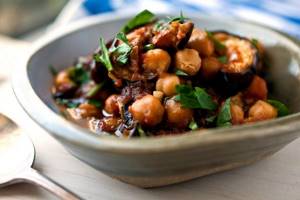
Stewed chickpeas with eggplant
Hummus
Nutritious and healthy hummus is prepared at home. For this you will need:
- 2 tbsp. chickpeas;
- 1/3 tbsp. sesame;
- ¼ tbsp. lemon juice;
- 1 tbsp. l. olive oil;
- 2-3 teeth. garlic;
- 1 pinch of salt.
Place all ingredients in a blender and blend until smooth.
Chickpea pasta
Before including chickpea pasta in your diet, you need to find out what its benefits and harms are. People suffering from gastrointestinal diseases should avoid using it, as chickpeas increase the release of gases in the intestines. You can buy the product in supermarkets. The cooking process is no different from cooking other types of pasta.
Canned product
The canned product does not require additional cooking. If dry chickpeas need to be soaked before cooking, then canned chickpeas are immediately added to the dish. It goes well with meat, complements salads, vegetable stews, or is used as a side dish.
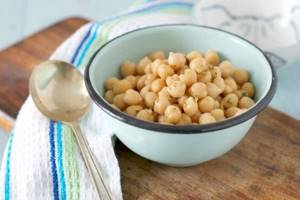
Before cooking, be sure to rinse the product with water.
The benefits of canned chickpeas are explained by the content of protein, dietary fiber, vitamins B, C, E and K. Minerals are also preserved: potassium, magnesium, phosphorus, iron, selenium. Excessive intake of the product can cause harm to health.
Abuse of canned chickpeas provokes excessive gas formation.
Who should eat chickpeas and who should avoid them?
Turkish peas have high nutritional and energy value. But since the product is slowly absorbed by the body, it does not increase blood sugar levels. Therefore, chickpeas can be consumed by people suffering from diabetes. Doctors have discovered that, despite the high calorie content, chickpeas strengthen the walls of blood vessels.
It does not contain harmful cholesterol. Therefore, the product will be useful for heart patients. But who needs to consume chickpeas in doses is those who vigilantly monitor the thinness of their waist. If you decide to treat yourself to crispy falafel or hummus, avoid other filling foods. Even a small portion of a dish made from chickpeas can dull the feeling of hunger for a long time.
